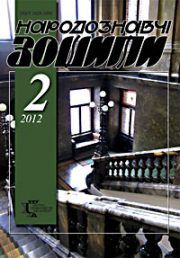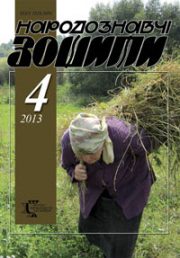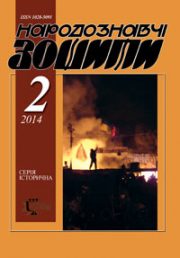The Ethnology Notebooks. 2023. № 3 (171), 505—510
UDK 303.042/[397+398]
DOI https://doi.org/10.15407/nz2023.03.505
IMPLEMENTATION OF THE STRUCTURAL AND FUNCTIONAL RESEARCH METHODOLOGY IN ETHNOLOGY
KUKHARENKO Oleksandr
- ORCID ID: https://orcid.org/0000-0001-5421-1004
- Candidate of Philological Sciences, Associate Professor,
- Associate Professor Kharkiv State Academy of Culture,
- 4, Bursatsky Descent, 61000, Kharkiv, Ukraine,
- Contacts: e-mail: art-red@ukr.net
Abstract. The purpose of the article is to establish which structures should be considered the most characteristic and typical for the founders of structural-functional analysis in ethnology — K. Levi-Strauss, A. Radcliffe-Brown, E. Leach, V. Turner, V. Propp. The relevance and scientific novelty of the topic lies in the fact that until now none of the numerous researchers of the school of functional structuralism has set himself a similar task. By the term «structure» the founders of the structural-functional method understood the orderly arrangement of elements or parts connected to each other in a much wider unity.
Having familiarized himself with almost all the main works of these scientists, the researcher singles out the main structure for each of them and demonstrates its functional capabilities. For Radcliffe-Brown, in the opinion of the author, the structure of the tribe and family relations between its members in one of the areas of Western Australia is fundamental. From the scientific heritage of Levi-Strauss, the structure of the division into components of the ancient Greek myth about Oedipus stands out. Characteristic for Leach is the structure of «condensation», in which two interconnected functions give rise to a third one, usually based on symbols and metaphors. Thanks to this, the researcher was able to clearly reveal the nature of Australian totemism, which no scientist could do before or after. A structure characteristic of Turner is a diagram of the spatial symbolism of a certain ritual of one Central African tribe. As an example of Propp’s structuralism, the division of a folk tale according to the functions of the actors is given, where each of the functions has a conventional designation, and as a result, we get the formula of the fairy tale plot.
The author of the article comes to the conclusion that the possibilities of the structural-functional method are far from existing and the specified method can be successfully used for the latest research in certain branches of ethnological science.
Keywords: ethnology, structuralism, structural-functional method, K. Levi-Strauss, A. Radcliffe-Brown, E. Leach, V. Turner, V. Propp.
Received 24.04.2023
REFERENCES
- Nikishenkov, A.A. (2008). History of British social anthropology. St. Petersburg: St. Petersburg Publishing University [in Russian].
- Lurie, S.V. (2005). Psychological anthropology: history, current state, prospects: Tutorial. 2nd ed. Moscow: Academic Project; Alma Mater [in Russian].
- Hsu, F.L.K. (1978). Passage to Understanding. The Making of Psychological anthropology (Pp. 140—156). Los Angeles.
- Radcliffe-Brown, A.R. (1949). Functionalism: A Protest. American Anthropologist, 2 (Vol. 51, pp. 320—323).
- Redkliff-Braun, A.R. (2001). Method in social anthropology. Moscow: KANON-press-Ts, Kuchkovo pole [in Russian].
- Levi-Stros, K. (1985). Structural anthropology. Moscow: Glav. red. vostochnoy literatury [in Russian].
- Lich, E. (2001). Culture and communication. The logic of the relationship of symbols. Moscow: Vostoch. lit-ra [in Russian].
- Gennep, A. van. (1999). Rites of passage. Systematic study of rituals. Moscow: Vostoch. Lit-ra [in Russian].
- Terner, V. (1983). Symbol and ritual. Moscow: Nauka [in Russian].
- Afanasiev, A.N. (1861). Folk Russian fairy tales (Issue 6). Moscow[in Russian].
- (1979). Comparative index of plots. East Slavic fairy tale. Leningrad: Science [in Russian].
- Uther, H.J. The Types of International Folktales. A Classification and Bibliography (Vol. 2).Helsinki: Academia Scientiarum Fennica.
- Propp, V.Ya. (1969). Morphology of a fairy tale. Moscow: Scie.






